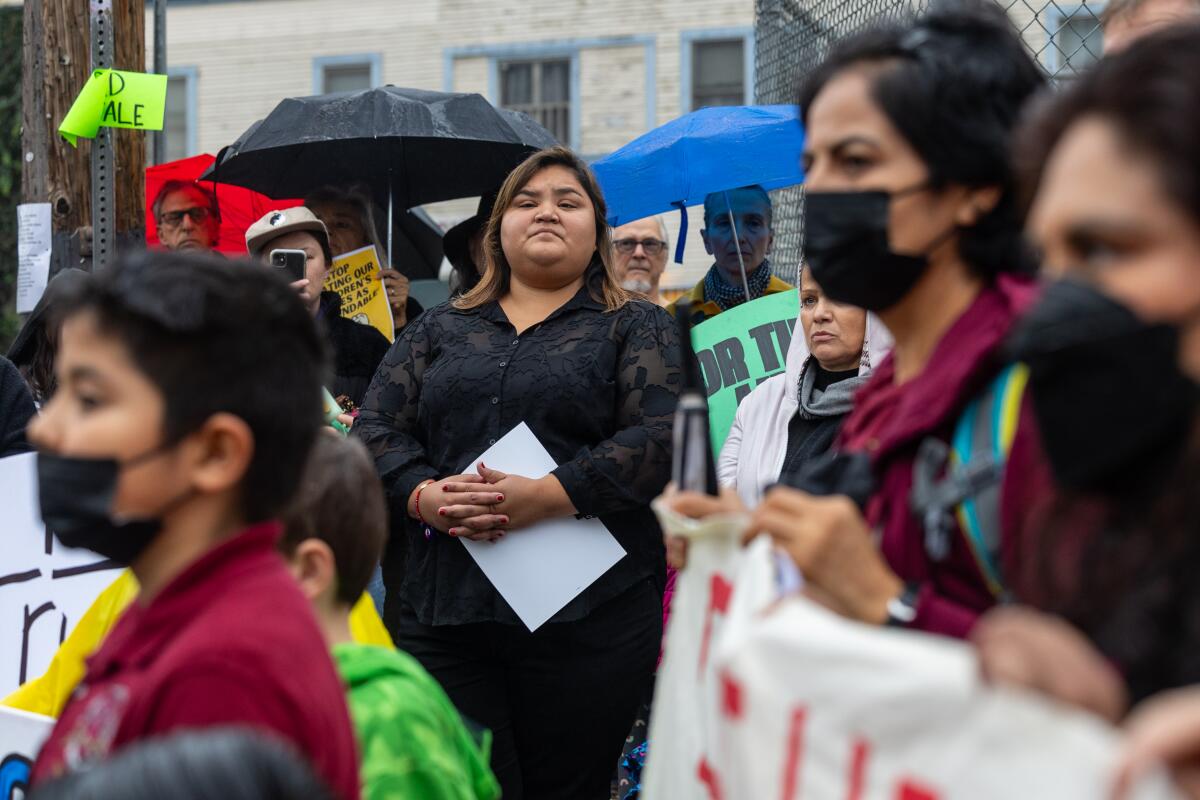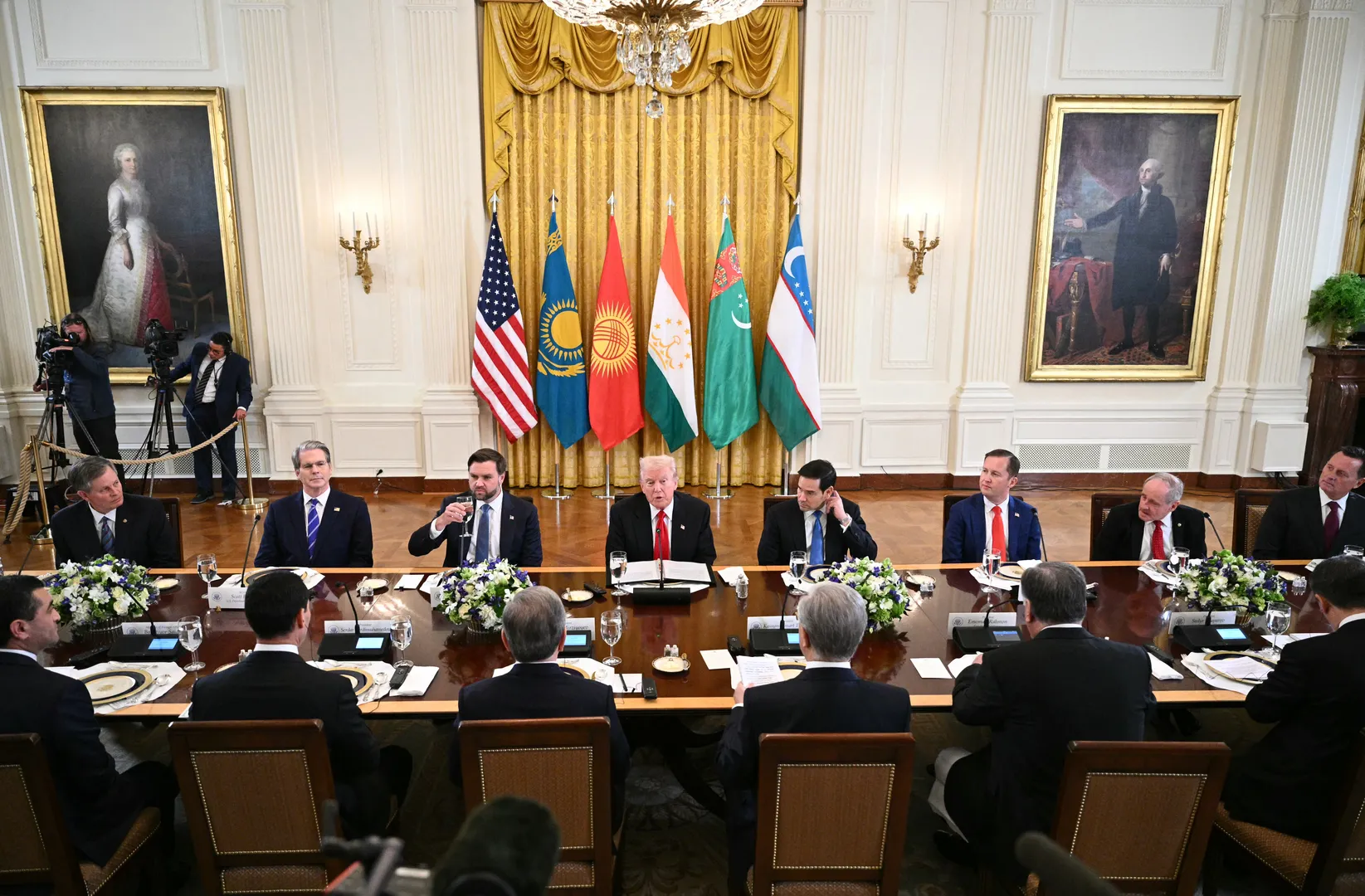Taking inspiration from Mamdani, democratic socialists look to expand their power in L.A.
The revelers who packed Tuesday’s election night party in L.A.’s Highland Park neighborhood were roughly 2,500 miles from the concert hall where New York City Mayor-elect Zohran Mamdani celebrated his historic win.
Yet despite that sprawling distance, the crowd, heavily populated with members of the L.A. chapter of Democratic Socialists of America, had no trouble finishing the applause lines delivered by Mamdani, himself a DSA member, during his victory speech.
“New York!” Mamdani bellowed on the oversized television screens hung throughout the Greyhound Bar & Grill. “We’re going to make buses fast and — “
“Free!” the crowd inside the bar yelled back in response.
In Los Angeles, activists with the Democratic Socialists of America have already fired up their campaigns for the June election, sending out canvassing teams and scheduling postcard-writing events for their chosen candidates. But they’re also taking fresh inspiration from Mamdani’s win, pointing to his inclusive, unapologetic campaign and his relentless focus on pocketbook issues, particularly among working-class voters.
The message that propelled Mamdani to victory resonates just as much in L.A., said City Councilmember Eunisses Hernandez, who won her seat in 2022 with logistical support from the DSA.
“What New York City is saying is that the rent is too damn high, that affordability is a huge issue not just on housing, but when it comes to grocery shopping, when it comes to daycare,” she said. “These are the things that we’re also experiencing here in Los Angeles.”
City Councilmember Eunisses Hernandez, appearing at a rally in Lincoln Heights last year, said New York City Mayor-elect Zohran Mamdani’s message will resonate in L.A.
(Jason Armond / Los Angeles Times)
DSA-LA, which is a membership organization and not a political party, has elected four of its endorsed candidates to the council since 2020, ousting incumbents in each of the last three election cycles. They’ve done so in large part by knocking on doors and working to increase turnout among renters and lower-income households.
The chapter hopes to win two additional seats in June. Organizers have begun contemplating a full-on socialist City Council — possibly by the end of 2028 — with DSA members holding eight of the council’s 15 seats.
“We would like a socialist City Council majority,” said Benina Stern, co-chair of DSA’s Los Angeles chapter. “Because clearly that is the logical progression, to keep growing the bloc.”
Despite those lofty ambitions, it could take at least five years before the L.A. chapter matches this week’s breakthrough in New York City.
Mayor Karen Bass, a high-profile leader within the Democratic Party with few ties to the DSA, is now running for a second term. Her only major opponent is former schools superintendent Austin Beutner, who occupies the center of the political spectrum in L.A. Real estate developer Rick Caruso, a longtime Republican who is now a Democrat, has not disclosed his intentions but has long been at odds with DSA‘s progressive policies.
In L.A., DSA organizers have put their emphasis on identifying and campaigning for candidates in down-ballot races, not citywide contests. Part of that is due to the fact that L.A. has a weak-mayor system, particularly when compared with New York City, where the mayor has responsibility not just for city services but also public schools and even judicial appointments.
L.A. council members propose and approve legislation, rework the budgets submitted by the mayor and represent districts with more than a quarter of a million people. As a result, DSA organizers have chosen the council as their path to power at City Hall, Stern said.
“The conditions in Los Angeles and New York I think are very different,” she said.
Since 2020, DSA-LA has been highly selective about its endorsement choices. The all-volunteer organization sends applicants a lengthy questionnaire with dozens of litmus test questions: Do they support diverting funds away from law enforcement? Do they oppose L.A.’s decision to host the Olympics? Do they support a repeal of L.A.’s ban on homeless encampments near schools?
Once a candidate secures an endorsement, DSA-LA turns to its formidable pool of volunteers, sending them out to help candidates knock on doors, staff phone banks and stage fundraising events.
During Tuesday’s party, DSA-LA organizers recruited new members to assist with the reelection campaigns of Hernandez and Councilmember Hugo Soto-Martínez, a former labor organizer. They distributed postcard-sized fliers with the message, “Hate Capitalism? So do we.”
Standing nearby was Estuardo Mazariegos, a tenant rights advocate now running to replace Councilmember Curren Price in a South L.A. district. Mazariegos, 40, said he first became interested in the DSA in the seventh grade, when his middle school civics teacher displayed a DSA flag in her classroom.
The crowd at the Greyhound in Highland Park reacts to results on Tuesday.
(Eric Thayer / Los Angeles Times)
Mazariegos hailed the results from New York and California, saying voters are “taking back America for the working people of America.” He sounded somewhat less excited about Bass, a former community organizer who has pursued some middle-of-the-road positions, such as hiring more police officers.
Asked if he supports Bass’ bid for a second term, Mazariegos responded: “If she’s up against a billionaire, yes.”
“If she’s up against another comrade, maybe not,” he added, laughing.
When Bass ran in November 2022, DSA-LA grudgingly recommended a vote for her in its popular voter guide, describing her as a “status quo politician.”
Councilmember Nithya Raman, who represents a Hollywood Hills district, is far more enthusiastic. Raman has worked closely with Bass on efforts to move homeless Angelenos indoors, while also seeking fixes to the larger systems that serve L.A.’s unhoused population.
“Karen Bass is the most progressive mayor we’ve ever had in L.A,” said Raman, who co-hosted the election night party with the other three DSA-aligned council members, DSA-LA and others.
Raman was the first of the DSA-backed candidates to win a council seat in L.A., running in 2020 as a reformer who would bring stronger renter protections and a network of community access centers to assist homeless residents.
Two years later, voters elected labor organizer Soto-Martínez and Hernandez. Tenant rights attorney Ysabel Jurado became the fourth last year, ousting Councilmember Kevin de León.
Stern, the DSA-LA co-chair, said she believes the four council members have brought a “sea change” to City Hall, working with their progressive colleagues to expand the city’s teams of unarmed responders, who are viewed as an alternative to gun-carrying police officers.
The DSA voting bloc also shaped this year’s city budget, voting to reduce the number of new recruits at the Los Angeles Police Department and preserve other city jobs, Stern said.
To be clear, the four-member bloc has pursued those efforts by working with other progressives on the council who are not affiliated with the DSA but more moderate on other issues. Beyond that, the group has plenty of detractors.
Stuart Waldman, president of the Valley Industry and Commerce Assn., said DSA-backed council members are making the city worse, by pushing for a $30 per hour hotel minimum wage and a $32.35 minimum wage for construction workers.
“No one is ever going to build a hotel in this city again, and DSA were a part of that,” he said. “Pretty soon no one will build housing, and the DSA is a part of that too.”
The union that represents LAPD officers vowed to fight the DSA’s effort to expand its reach, saying it would work to ensure that “Angelenos are not bamboozled by the socialist bait and switch.”
“Socialists want to bait Angelenos into talking about affordability, oppression and fairness, get their candidates elected, and then switch to enact their platform that states ‘Defund the police by rejecting any expansion to police budgets … while cutting [police] budgets annually towards zero,’” the union’s board of directors said in a statement.
In New York City, Mamdani has proposed a series of measures to make the city more affordable, including free bus fares, city-run grocery stores and a four-year freeze on rent increases inside rent stabilized apartment units.
Some of those ideas have already been tried in L.A.
In 2020, weeks into the COVID-19 shutdown, Mayor Eric Garcetti placed a moratorium on rent hikes for more than 600,000 rent-stabilized apartments. The council kept that measure in place for four years.
Around the same time, L.A. County’s transit agency suspended mandatory collection of bus fares. The agency started charging bus passengers again in 2022.
City Councilmembers Nithya Raman and Eunisses Hernandez celebrate at the election night party they co-hosted with Democratic Socialists of America’s L.A. chapter and two other council members.
(Eric Thayer / Los Angeles Times)
In recent months, the DSA-LA has pushed for new limits on rent increases inside L.A.’s rent-stabilized apartments. Raman, who chairs the council’s housing committee, is backing a yearly cap of 3% in those buildings, most of which were built before October 1978.
Hernandez, whose district stretches from working-class Westlake to rapidly gentrifying Highland Park, is a believer in shifting the Overton Window at City Hall — moving the political debate left and “putting people over profits.”
Like others at the election party, Hernandez is hoping the council will eventually have eight DSA-aligned members in the coming years, saying such a shift would be a “game changer.” With a clear majority, she said, the council would not face a huge battle to approve new tenant protections, expand the network of unarmed response teams and place “accountability measures” on corporations that are “making money off our city.”
“There’s so many things … that we could do easier for the people of the city of Los Angeles if we had a majority,” she said.

